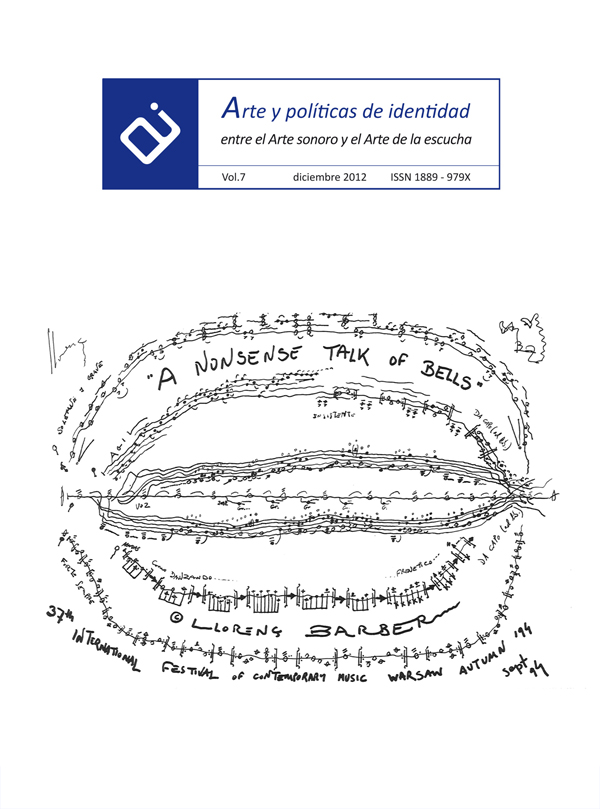Observatory of the Urban Transformation of the Sound: The City like Text, Drifts, Maps and Sonorous Cartography.
Abstract
Sound Mapping: Observatory of Urban Transformation of Sound. Artistic space is a sound composition and a reflection of structural changes in the city. The studies on soundscape, are defined by sound traces of mobility that make up the identity of each place and the sound memory of its inhabitants. Social mapping represents visible and invisible fluxes. It is a map of experimentation and interpretation of an everyday reality which operates within global and local spheres simultaneously. The information reflected is multi-layered and contains a hidden frame of relationships that shape the social reality. Decode sound information of the city as a mutable, superimposed and disseminated entity, to study urban sound layers, using sound mapping of urban spaces and areas sensitive to urban transformation, and to identify their components. The conclusions apply aspects of the organizational ability of art, through strategies of observing and perceiving reality.
Downloads
-
Abstract1970
-
PDF (Español (España))925
References
Alexander, Ch. (1971). Tres aspectos de matemática y diseño: La estructura del Medio Ambiente. Barcelona: Tusquets Ed.
Augé, M. (1992). Los no lugares. Espacios del anonimato .Una antropología de la sobremodernidad. Barcelona: Gedisa Editorial.
Berger, J. (2011). Sobre el dibujo. Barcelona: Gustavo Gili.
Boulez, P. (2003). Pli selon pli. Genéve: Contrechamp.
Bourgin, V.(2004). Ensayos. Barcelona: Gustavo Gili.
Breton, A. (1993). Lire le regard. Lovaine: Lachenal & Ritter.
Briggs, J. & Peat, D. (1999). Las siete leyes del caos. Barcelona: Grijalbo.
Bitbol, M. (2010). De l’interieur du monde. Pour une philosophie des relations.Paris: Flammarion.
Careri, F. (2002). Walkscapes. El andar como práctica estética. Barcelona: Gustavo Gili.
Certeau, M. de (1984). The Practice of Everyday Life. Berkeley: University of California Press.
Chatwin, B. (1987). The Songlines. New York: Penguin Books.
Cole, K.C. (1999). El universo y la taza de té. Barcelona: Ediciones B.
Debord, G. (1999). Internacional situacionista, vol. I: La realización del arte . Madrid: Literatura Gris.
Deleuze, G. (1988). Diferencia y repetición. Gijón: Júcar Universidad.
Delgado, M. (2007). Sociedades movedizas,. Pasops hacia una antropologia de las calles. Barcelona: Anagrama.
Diccionario Metápolis de Arquitectura Avanzada. (2001). Barcelona: Actar.
During, E. (2010). Faux raccords. Villa Arson: Actes Sud.
Escohotado, A. (1999). Caos y orden. Madrid: Espasa Calpe.
Foucault, M. (1997). Las palabras y las cosas. Una arqueología de las ciencias humanas. Madrid: Siglo XXI.
---------------- (1986). La pensée du dehors. Paris: Fata Morgana.
Gardner, M. (1995). Complejidad, el caos como generador de orden. Barcelona: Tusquets editores.
Gros, F. (2009) Marcher, une philosophie. París: Carnets Nord.
Gruzinsky, S. (2000). El pensamiento mestizo. Barcelona: Paidós
Holgar, V.B. y Romero, F. (1998). Arte Fractal, estética del localismo. Braunchweig/Barcelona: ADI Arbeisstelle für Designinformátic.
Henry, M. (2008). Ver lo invisible. Madrid: Siruela.
Holl, S. (2011). Cuestiones de percepción. Barcelona: Gustavo Gili.
Keats, J. (2010). Belleza y verdad. Valencia: Ed. Pre-Textos.
Lynch, K. (1960). The image of the city. Cambridge: The Technology press and Harvard University press.
Martinez, L. (2004). Intersecciones. Madrid: Editorial Rueda.
Merleau-Ponty, M. (2002). Phenomenology of Perception. London: Routledge.
Mengs, A. (2004). Stalker de Andrei Tarkovsky. Madrid: Rialp.
Molderings, H. (2007).L’art comme expérience, les 3 stoppages étalon de Marcel Duchamp. París: Maison des Sciences de l’Homme.
Morin, E. (2000). La mente bien ordenada. Barcelona: Seix Barral.
Nogué, A. y Canadell, E. (2010). Art i Ciència. Converses. Barcelona: Edicions UB.
Nogué, J. (2009). Entre Paisajes. Barcelona: Àmbit.
Orquesta del Caos (n.d.) Sonidos en causa. Revisado el 20 de noviembre de 2012 de http://www.sonoscop.net/sonoscop/sonidosencausa/index.html
Perec, G. (1999). Especie de Espacios. Barcelona: Montesinos.
------------ (2001). Pensar, clasificar. Barcelona: Gedisa.
------------ (2008). Lo infraordinario. Madrid: Impedimenta.
Perejaume, (1998). Oïsme. Barcelona: Proa.
Queneau, R. (1947). Exercise de Style. Paris: Editions Gallimard.
Schopenhauer, A. (2009). El mundo como voluntad y representación. Madrid: Trotta.
Seel, M. (2011). Estética del aparecer. Madrid: Katz editores.
Wagensberg, J. (2004). La Rebelión de las formas o cómo preservar cuando la incertidumbreaprieta. Barcelona: Metatemas23, libros para pensar la ciencia.
Works published in this journal are subject to the following terms:
- The Service of Publications from the University of Murcia (publishing house) keeps the published works’ copyrights, and favors and allows the reuse of these works under the license indicated in point 2.
- Works are published in the journal’s online edition under the license Creative Commons Reconocimiento-NoComercial-SinObraDerivada 3.0 España(texto legal). They can be copied, used, disseminated, transmitted and publicly exhibited, as long as: i) the author and original source of publication are cited (journal, publishing house and work’s URL); ii) they are not used for commercial purposes; iii) the existence and specifications of this license are mentioned.
3. Conditions for auto-file. It is allowed and encouraged that authors share electronically their pre-print version (the pre-reviewed version) and /or post-print version (the reviewed and accepted version) of their Works before the publication, since it promotes its circulation and dissemination. RoMEO color: green.










